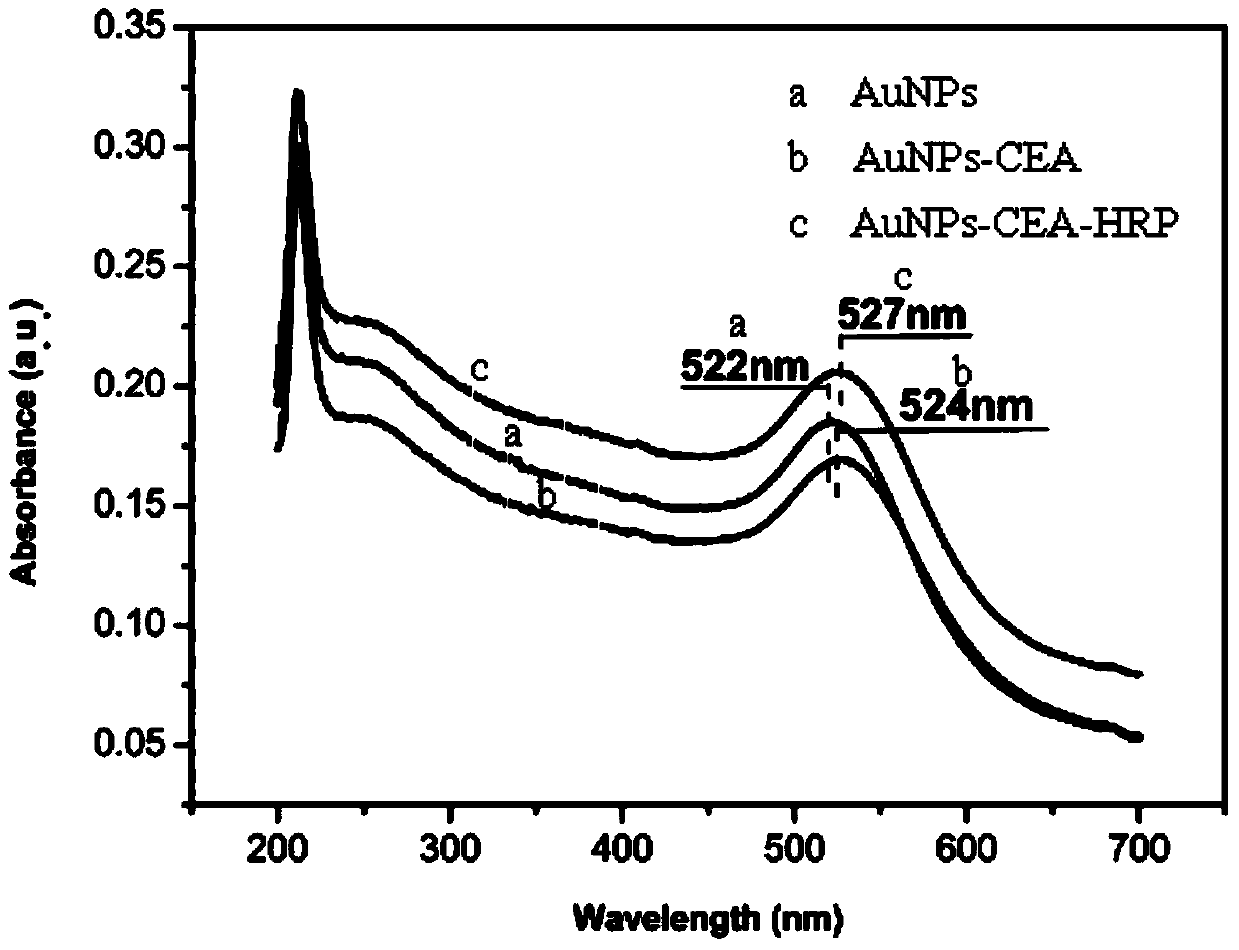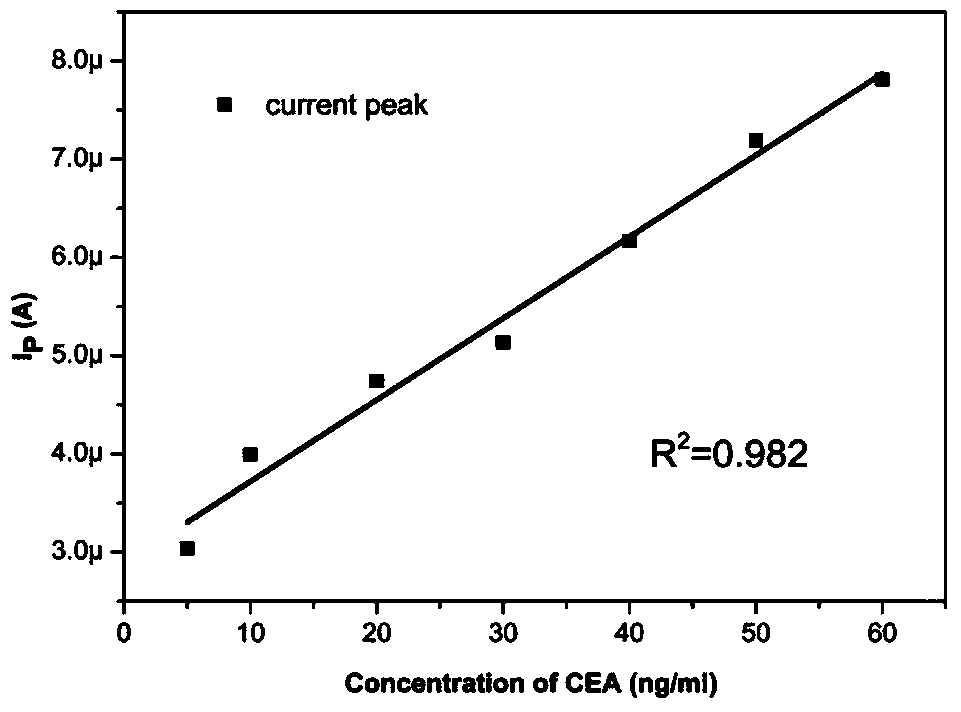Nano-particle enhancement detection device based on non-modified monolayer graphene being used as working electrode and application thereof
A single-layer graphene and nanoparticle technology, applied in the field of detection, can solve problems such as low conduction electrons, and achieve the effects of improving detection efficiency, saving resources and improving accuracy
- Summary
- Abstract
- Description
- Claims
- Application Information
AI Technical Summary
Problems solved by technology
Method used
Image
Examples
Embodiment 1
[0108] (1) Preparation of gold nanoparticles (diameter 20nm) coated with the detected protein and HRP:
[0109] First, prepare colloidal gold according to the method of Yu et al. (Yu et al., 2012), synthesize gold nanoparticles with a diameter of 20nm, and then take 200ul prepared nano-gold colloid solution (diameter 20nm, 6.8×10 ‐9 mol / L), add 2ul of K 2 CO 3 (wt.0.1%) to adjust its pH=8.9, then add 1ul (1mg / ml) CEA antibody and 1ul (1mg / ml) HRP, let it stand at room temperature for half an hour, centrifuge (9000rmp, 50min), remove the supernatant, Resuspend with PBS (pH7.4), add BSA (0.1%), and store at 2‐8°C. The ultraviolet spectrum of the obtained nano-gold is as figure 1 shown.
[0110] (2) Preparation of magnetic beads coated with captured protein:
[0111] Take 50ul, 10mg / ml carboxylated magnetic beads (Invitrogen, Cat.no.650.11 / 12), wash twice with an equal volume of MES (25mM, pH6.0), each time for 10 minutes, magnetically separate, and remove the supernatant ;...
Embodiment 2
[0115] (1) Preparation of gold nanoparticles (diameter 19nm) coated with the protein to be tested and HRP: First, gold nanoparticles with a diameter of 20nm were synthesized according to the method of colloidal gold prepared by Yu et al. (Yu et al., 2012), and then Take 200ul prepared nano-gold colloid solution (diameter 20nm, 6.8×10 ‐10 mol / L), add 2ul of K 2 CO 3 (wt.0.1%) to adjust its pH=9.2, then add 0.9ul (1.1mg / ml) of CEA antigen and 0.9ul (1.1mg / ml) of HRP, let stand at room temperature for half an hour, centrifuge (9000rmp, 50min), Remove the supernatant, resuspend with PBS (pH7.0), add BSA (0.5%), and store at 2‐8°C.
[0116] (2) Preparation of magnetic beads coated with captured protein:
[0117] Take 50ul, 10mg / ml carboxylated magnetic beads (Invitrogen, Cat.no.650.11 / 12), wash twice with an equal volume of MES (25mM, pH6.0), each time for 10 minutes, magnetically separate, and remove the supernatant Add 60ul of freshly prepared EDC (40mg / ml) and 60ul of NHS (4...
Embodiment 3
[0121] (1) Preparation of gold nanoparticles (diameter 21nm) coated with the detected protein and HRP:
[0122] First, prepare colloidal gold according to the method of Yu et al. (Yu et al., 2012), synthesize gold nanoparticles with a diameter of 20nm, and then take 200ul prepared nano-gold colloid solution (diameter 20nm, 6.8×10 ‐8 mol / L), add 2ul of K 2 CO 3 (wt.0.1%) to adjust its pH=8.6, then add 1.1ul (0.9mg / ml) mouse anti-human IgG antibody and 1.1ul (0.9mg / ml) HRP, let stand at room temperature for half an hour, centrifuge (9000rmp, 50min), remove the supernatant, resuspend with PBS (pH7.8), add BSA (0.1%), and store at 2‐8°C.
[0123] (2) Preparation of magnetic beads coated with captured protein:
[0124]Take 50ul, 10mg / ml carboxylated magnetic beads (Invitrogen, Cat.no.650.11 / 12), wash twice with an equal volume of MES (25mM, pH6.0), each time for 10 minutes, magnetically separate, and remove the supernatant ;Add freshly prepared 40ul EDC (60mg / ml) and 40ul NHS (...
PUM
| Property | Measurement | Unit |
|---|---|---|
| Diameter | aaaaa | aaaaa |
| Diameter | aaaaa | aaaaa |
Abstract
Description
Claims
Application Information
 Login to View More
Login to View More - R&D
- Intellectual Property
- Life Sciences
- Materials
- Tech Scout
- Unparalleled Data Quality
- Higher Quality Content
- 60% Fewer Hallucinations
Browse by: Latest US Patents, China's latest patents, Technical Efficacy Thesaurus, Application Domain, Technology Topic, Popular Technical Reports.
© 2025 PatSnap. All rights reserved.Legal|Privacy policy|Modern Slavery Act Transparency Statement|Sitemap|About US| Contact US: help@patsnap.com



